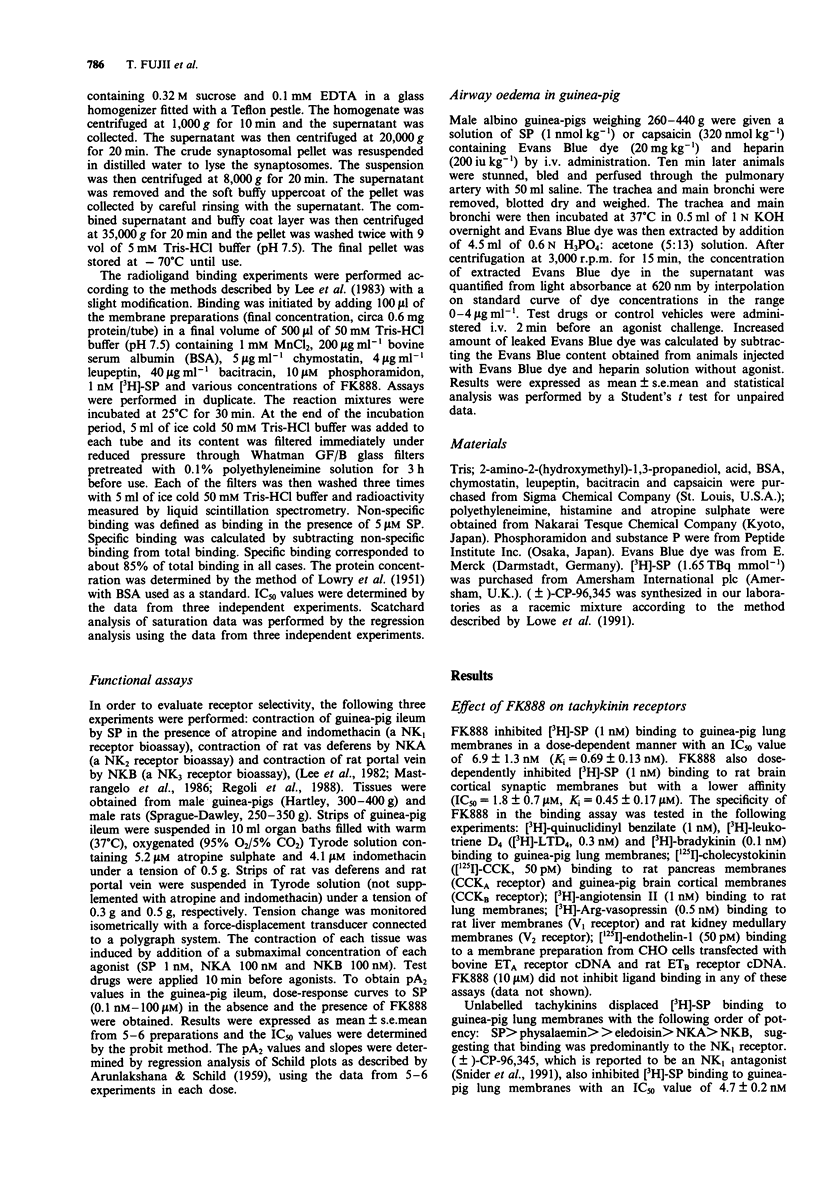Abstract
1. In our search for compounds that inhibit the binding of [3H]-substance P (SP) to guinea-pig lung membranes, the dipeptide SP antagonist, FK888, was developed by chemical modification of the parent compound, (D-Pro4, D-Trp7,9,10, Phe11)SP4-11. 2. In a [3H]-SP binding assay using guinea-pig lung membranes and rat brain cortical synaptic membranes, FK888 displaced [3H]-SP binding with a Ki value of 0.69 +/- 0.13 nM and 0.45 +/- 0.17 microM, respectively, in a competitive manner. 3. FK888 inhibited the contraction of guinea-pig isolated ileum induced by SP in the presence of atropine and indomethacin (a NK1 receptor bioassay) with a pA2 value of 9.29 (8.60-9.98). 4. FK888 inhibited contractions of rat vas deferens by NKA (a NK2 receptor bioassay) and of rat portal vein by NKB (a NK3 receptor bioassay) at concentrations at least 10,000 times greater than that required to inhibit contractions of guinea-pig ileum. 5. FK888 also inhibited SP-induced airway oedema in guinea-pig after both intravenous and oral administration. 6. These data demonstrate that FK888 is a potent and selective NK1 antagonist which is active both in vitro and in vivo.
Full text
PDF




Selected References
These references are in PubMed. This may not be the complete list of references from this article.
- ARUNLAKSHANA O., SCHILD H. O. Some quantitative uses of drug antagonists. Br J Pharmacol Chemother. 1959 Mar;14(1):48–58. doi: 10.1111/j.1476-5381.1959.tb00928.x. [DOI] [PMC free article] [PubMed] [Google Scholar]
- Beresford I. J., Birch P. J., Hagan R. M., Ireland S. J. Investigation into species variants in tachykinin NK1 receptors by use of the non-peptide antagonist, CP-96,345. Br J Pharmacol. 1991 Oct;104(2):292–293. doi: 10.1111/j.1476-5381.1991.tb12423.x. [DOI] [PMC free article] [PubMed] [Google Scholar]
- Fardin V., Garret C. Species differences between [3H] substance P binding in rat and guinea-pig shown by the use of peptide agonists and antagonists. Eur J Pharmacol. 1991 Aug 29;201(2-3):231–234. doi: 10.1016/0014-2999(91)90350-y. [DOI] [PubMed] [Google Scholar]
- Fujii T., Murai M., Morimoto H., Nishikawa M., Kiyotoh S. Effects of actinomycin D on airway constriction induced by tachykinins and capsaicin in guinea-pigs. Eur J Pharmacol. 1991 Mar 5;194(2-3):183–188. doi: 10.1016/0014-2999(91)90103-w. [DOI] [PubMed] [Google Scholar]
- Garret C., Carruette A., Fardin V., Moussaoui S., Peyronel J. F., Blanchard J. C., Laduron P. M. Pharmacological properties of a potent and selective nonpeptide substance P antagonist. Proc Natl Acad Sci U S A. 1991 Nov 15;88(22):10208–10212. doi: 10.1073/pnas.88.22.10208. [DOI] [PMC free article] [PubMed] [Google Scholar]
- Gitter B. D., Waters D. C., Bruns R. F., Mason N. R., Nixon J. A., Howbert J. J. Species differences in affinities of non-peptide antagonists for substance P receptors. Eur J Pharmacol. 1991 May 17;197(2-3):237–238. doi: 10.1016/0014-2999(91)90532-u. [DOI] [PubMed] [Google Scholar]
- LOWRY O. H., ROSEBROUGH N. J., FARR A. L., RANDALL R. J. Protein measurement with the Folin phenol reagent. J Biol Chem. 1951 Nov;193(1):265–275. [PubMed] [Google Scholar]
- Lee C. M., Iversen L. L., Hanley M. R., Sandberg B. E. The possible existence of multiple receptors for substance P. Naunyn Schmiedebergs Arch Pharmacol. 1982 Mar;318(4):281–287. doi: 10.1007/BF00501166. [DOI] [PubMed] [Google Scholar]
- Lee C. M., Javitch J. A., Snyder S. H. 3h-substance P binding to salivary gland membranes. Regulation by guanyl nucleotides and divalent cations. Mol Pharmacol. 1983 May;23(3):563–569. [PubMed] [Google Scholar]
- Maggi C. A., Giuliani S., Ballati L., Lecci A., Manzini S., Patacchini R., Renzetti A. R., Rovero P., Quartara L., Giachetti A. In vivo evidence for tachykininergic transmission using a new NK-2 receptor-selective antagonist, MEN 10,376. J Pharmacol Exp Ther. 1991 Jun;257(3):1172–1178. [PubMed] [Google Scholar]
- Mastrangelo D., Mathison R., Huggel H. J., Dion S., D'Orléans-Juste P., Rhaleb N. E., Drapeau G., Rovero P., Regoli D. The rat isolated portal vein: a preparation sensitive to neurokinins, particularly neurokinin B. Eur J Pharmacol. 1987 Feb 24;134(3):321–326. doi: 10.1016/0014-2999(87)90363-3. [DOI] [PubMed] [Google Scholar]
- Mizrahi J., Escher E., D'Orléans-Juste P., Regoli D. Undeca- and octa-peptide antagonists for substance P, a study on the guinea pig trachea. Eur J Pharmacol. 1984 Mar 23;99(2-3):193–202. doi: 10.1016/0014-2999(84)90241-3. [DOI] [PubMed] [Google Scholar]
- Morimoto H., Murai M., Maeda Y., Hagiwara D., Miyake H., Matsuo M., Fujii T. FR 113680: a novel tripeptide substance P antagonist with NK1 receptor selectivity. Br J Pharmacol. 1992 May;106(1):123–126. doi: 10.1111/j.1476-5381.1992.tb14303.x. [DOI] [PMC free article] [PubMed] [Google Scholar]
- Morimoto H., Murai M., Maeda Y., Yamaoka M., Nishikawa M., Kiyotoh S., Fujii T. FK 224, a novel cyclopeptide substance P antagonist with NK1 and NK2 receptor selectivity. J Pharmacol Exp Ther. 1992 Jul;262(1):398–402. [PubMed] [Google Scholar]
- Murai M., Morimoto H., Maeda Y., Kiyotoh S., Nishikawa M., Fujii T. Effects of FK224, a novel compound NK1 and NK2 receptor antagonist, on airway constriction and airway edema induced by neurokinins and sensory nerve stimulation in guinea pigs. J Pharmacol Exp Ther. 1992 Jul;262(1):403–408. [PubMed] [Google Scholar]
- Norman P., Abram T. S., Kluender H. C., Gardiner P. J., Cuthbert N. J. The binding of [3H]leukotriene C4 to guinea-pig lung membranes. The lack of correlation of LTC4 functional activity with binding affinity. Eur J Pharmacol. 1987 Nov 17;143(3):323–334. doi: 10.1016/0014-2999(87)90456-0. [DOI] [PubMed] [Google Scholar]
- Pernow B. Substance P. Pharmacol Rev. 1983 Jun;35(2):85–141. [PubMed] [Google Scholar]
- Regoli D., Drapeau G., Dion S., Couture R. New selective agonists for neurokinin receptors: pharmacological tools for receptor characterization. Trends Pharmacol Sci. 1988 Aug;9(8):290–295. doi: 10.1016/0165-6147(88)90013-2. [DOI] [PubMed] [Google Scholar]
- Snider R. M., Constantine J. W., Lowe J. A., 3rd, Longo K. P., Lebel W. S., Woody H. A., Drozda S. E., Desai M. C., Vinick F. J., Spencer R. W. A potent nonpeptide antagonist of the substance P (NK1) receptor. Science. 1991 Jan 25;251(4992):435–437. doi: 10.1126/science.1703323. [DOI] [PubMed] [Google Scholar]
- Zukin S. R., Young A. B., Snyder S. H. Gamma-aminobutyric acid binding to receptor sites in the rat central nervous system. Proc Natl Acad Sci U S A. 1974 Dec;71(12):4802–4807. doi: 10.1073/pnas.71.12.4802. [DOI] [PMC free article] [PubMed] [Google Scholar]


